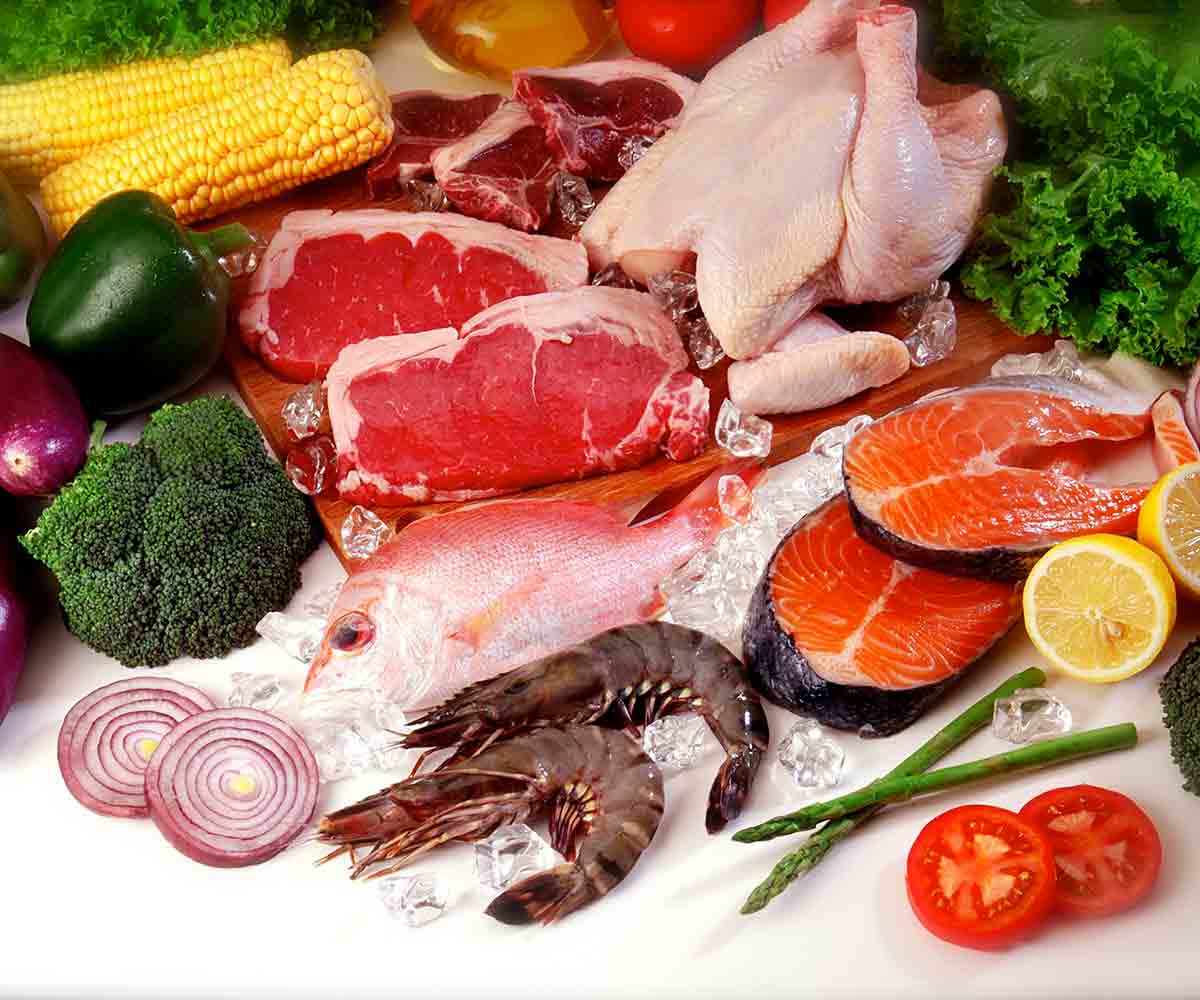One of the most controversial and curious subjects in modern nutrition is the place of animal protein in a healthy diet. The evidence has been building over the past twenty years that our reliance on meat and dairy foods are a mistake. Most epidemiological studies indicate that excessive consumption of meat and dairy is a primary factor in most degenerative disease. These studies, coupled with the fact that the economic and environmental damage of the modern meat and dairy industries far outweighs its social and nutritional value, do not seem to shake the public belief that animal fats and protein are essential for a healthy diet.
That more and more people reject these foods on ethical grounds related to the animal abuse sets the stage for a food fight of epic proportions.
There is certainly adequate information regarding the horrific and unhealthy conditions that factory-farming methods impose on cows, pigs, chicken, and fish as well as the many other animals that are slaughtered for food daily. Most people would not eat the meat they consume daily if they had to witness the events that brought it to market. The fact that we need around 150 billion animals killed every year to survive seems strange when we look at the physical, anthropological and nutritional facts. We can only come to one conclusion – the argument has nothing to do with nutrition, science, compassion or common sense. No – the subject of animal food consumption is ruled largely by emotion and cultural mythologies.
Against the backdrop of the linkage between animal products and the increases in heart disease, stroke, cancers and even diabetes we have to ask ourselves what kind of visions or urges could bolster the desire to continue using meat as even a small part of a healthy diet.
Several spring to mind:
- The brave hunter returns to the cave with an antelope strapped on his back, which he offers his family as they cower in the shadows of their cave.
- The independent cowboy hunkers down beside the campfire for a big plate of fried meat and cornbread.
- The wealthy landowner sits down to the groaning table filled with roasted birds, fish and leg of lamb.
- Dad fires up the grill and throws on the burgers and hot dogs; the flags are flying.
Powerful images that operate below the surface of consciousness often define who we think we are. Man the hunter, rugged individualism, dominion over the earth, wealth and shared experience all factor in our attitudes regarding what we eat and how we use all of the resources essential to our existence. What arguments could the proponents of a meat-rich diet possibly use to justify this habit that is creating illness, brutality and ecological ruin? Well, the answers to that question are simple: a heady mix of bad science and a fear of change.
Is Meat Part Of Our Destiny?
One of the most interesting arguments supporting the eating of meat is that we are omnivorous; we can eat it all. I would never argue with that. Early humans ate a varied diet that probably included insects, small game, fruits and plants. I am not aware of any logical contradiction to this idea.
The issue here is that we were not “natural carnivores” in the accepted definition of the word. A carnivore is an animal that has a diet mainly or exclusively of animal meat. This meat can be obtained through either hunting and killing or scavenging the leftovers from what other animals kill. The academic arguments continue regarding the dietary details of our evolution but certain compelling facts emerge that challenge many cultural mythologies.
The most accurate indications of early diet are to be found in the mouth and intestinal tract. This is where the history of any animal’s dietary past is reflected most dramatically. Indications of the earliest human remains show that man was never a true carnivore. In fact, meat (other than insects) was probably a rather small part of dietary consumption. The proof of this lies in both human structure and function.
Starting from the most mentioned and most obvious, our so-called canine teeth don’t qualify us as carnivores.
They are placed back toward the outer corners of the mouth and they are not long enough, large enough or strong enough to grip, hold and tear flesh. There is no evidence in the fossil record that we have ever had the sharp, developed teeth to tear meat or the jaw joints to hold or grind bones with any effectiveness, let alone the claws that are essential tools for the capture and kill.
The issue of cheeks is one that often brings a laugh when I bring it up in lectures. Carnivores don’t have cheeks; they don’t need them. You don’t keep meat in your mouth; you only have cheeks when you keep food in your mouth to aid digestion and to masticate. Humans have digestive enzymes to digest complex carbohydrates (not needed for carnivores); we do not develop these capacities unless they are essential for our existence.
The same indications are there in the human intestinal tract.
Carnivores have very short intestines with fairly smooth walls. Meat fiber is not beneficial to intestinal health in any animal; when the surface nutrients are released from meat the intestines need to be flushed. Herbivores and humans have a longer (two to three times as long), more complex digestive tract that holds vegetable fiber longer to achieve maximum efficiency to support the growth of beneficial microorganisms.
All of these features take us back over a hundred thousand years, far before the development of tools or practical use of fire. One of the problems that emerge in interpreting all these indications of our original diet is the fact that one of our most precious gifts is our adaptability.
The first humans left their African home 1.8 to 1.3 million years ago, depending on which of the current migratory theories you apply. As we traveled, and as other waves of migration worked their way North, we were forced to adapt to new environments. As tribes moved into the colder and less fertile lands, it was important to follow herds of animals and to rely more on animal sources of food for survival. Those tribes who remained in the cooler climates retained their relationship to animals as a food source either in the wild or eventually domesticated and used for milk products.
Over thousands of years, this adaptation included the sophistication of tool-making, the control and use of fire for cooking and warmth, and eventually, agriculture. From 20,000 to 10,000 years ago, agriculture slowly developed and with it cooking.
Anthropologists tell us that during this period the primary development in human biology was an enlargement in brain size.
This growth in the brain is attributed to the fact that cooking made digestion more efficient and allowed more caloric energy for the development of the brain. If this is true it would indicate a movement away from our original diet to meet the challenges of migration and environment and then an adaptation to a more plant-based diet to meet the social and physical needs of an increased population and a more settled cultural life. All of these changes were in service of staying alive.
Tradition and Evolution
When I ask clients to describe their diet the two most common answers are, “I eat a really good diet” (everything is relative) and “I was raised on a traditional diet, I like my meat and potatoes.” The former is usually the female answer and the latter comes mostly from men. Tradition gets used as a reason for a multitude of sins. If it was good enough for Grandpa, it is good enough for me.
When I started to eat a macrobiotic diet in the mid-60s, my grandfather told me that I was eating more like he did as a child.
His family lived on porridge, bread, vegetables, beans and small game with very little red meat. He thought it was funny and he loved the food.
The amount of meat in the diets of most people 100 years ago was very small; it was chemical-free and free-range or grazed. I have found this to be true in every country I have visited; if you ask the elders, their diet included less meat unless they were quite wealthy.
There has been a long association between wealth and meat-eating, the wealthiest get the best cuts, and the poor get what’s left. This is still true today; meat-eating and the abundance of food is often associated with success. It has always been the rich who were overweight; with the shift in the modern diet, the tables are turned.
Food abundance and plentiful meat and dairy are now the staples of the fast food diet.
Obesity is now available for everyone – how democratic. The only problem is that the meat being consumed is still the scrap. The popular, fast-food hamburger can contain as little as 15% meat and includes bones, connective tissue, blood vessels, fat, water, nerves, cartilage and plant-based fillers. No one wants to know what’s in a hot dog. So-called traditions of meat-eating serve those who sell meat but are not a reflection of reality. The question still hangs in the air; even if our ancestors ate meat as their primary food, why should that affect our diet today?
Human evolution is dominated by two influences: physical adaptation and cultural adaptation.
Physical adaptation is a reflection of our ability to meet the challenges and changes in the environment as reflected in physical form and function. These changes represent the raw desire for survival. Cultural evolution represents a different and unique aspect of human life. We develop ideas that drive and inform our attitudes and actions, which are reflected in social institutions and the ways we alter our environment. The environment we are now adapting to is one of our own making.
Over the past 10,000 years, human societies have reversed the swing of evolution. We have changed the environment we adapt to, we are in the process of altering the source of our life and we are doing it without any conscious vision of the result. Human culture has made forests disappear, changed the course of rivers, altered the atmosphere and changed the composition of the seas. The crucible out of which life emerged has been bent to the will of humanity, mostly for the worse.
Our attitudes regarding food are an important part of this process.
The gift of consciousness, our capacity to be aware of our actions and the implications of them, is a great gift if we use it. Tradition is a social habit. As with any habit, tradition should be assessed as either improving or diminishing the quality of individual and social life.
With consciousness, we may feel that some traditions that fill an important need are worth retaining, others may have outlived their use based on ignorance, and they need to be replaced. To retain any tradition out of misplaced nostalgia is ill-advised. I loved my grandparents very much but am quite happy to leave some of their prejudices and beliefs in the past since they do not serve in the present.
The development of technologies and the speed of social change make many people anxious about the course of society. This anxiety often produces irrational fears as we move into uncharted territory. The course of history makes demands on us, all to reassess what is of true value, not only in the moment but also for the future.
When we approach the issue of nutrition, the demand is that we move beyond the restraints of imagined tradition and ask ourselves how we create a healthy and environmentally sound diet that is flexible enough to adapt to personal needs, diverse enough to satisfy the senses, and capable of feeding a hungry world with the least environmental impact.
This is not only possible but urgently needed.
One of the habits we have to leave behind is our dependence on animals as a primary food source. It is wasteful, unhealthy and produces environmental chaos. The way forward is to continue to advocate eating low on the food chain, to promote education of the young on the benefits of healthy eating, to support organic agriculture and demand politicians to have the courage to confront the massive agriculture and food monopolies and make them accountable for the quality of their food.
There is no benefit in respecting tradition if it poisons the future.
Since 1967, Californian, Bill Tara has been an active advocate for natural heath care. He was the Vice President of Erewhon Trading Company, one of America’s first national distributors of organic foods, and was a co-founder of Sunwheel Natural Foods in London, England. He has been a health counsellor, teacher, author, entrepreneur and creator of health education centres in Europe and North America.




